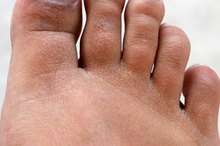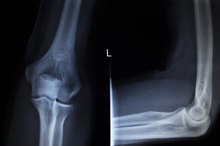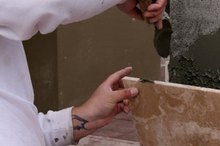What does fact checked mean?
At Healthfully, we strive to deliver objective content that is accurate and up-to-date. Our team periodically reviews articles in order to ensure content quality. The sources cited below consist of evidence from peer-reviewed journals, prominent medical organizations, academic associations, and government data.
The information contained on this site is for informational purposes only, and should not be used as a substitute for the advice of a professional health care provider. Please check with the appropriate physician regarding health questions and concerns. Although we strive to deliver accurate and up-to-date information, no guarantee to that effect is made.
Apple Cider Vinegar for Bursitis
Apple cider vinegar -- a type of vinegar made from apples -- is a folk remedy for a wide variety of conditions including bursitis, a painful condition that affects the pads that cushion your bones and tendons 2. Proponents claim that although apple cider vinegar is acidic, it helps make your body more alkaline and that this effect can help heal a number of conditions. There is no scientific evidence showing apple cider vinegar is effective for bursitis.
Bursitis
Bursae are fluid-filled pads that cushion the tendons, muscles and bones near your joints. When these pads become inflamed, it is known as bursitis. Your shoulders, elbows and hips are the most commonly affected areas, according to MayoClinic.com 1. You may feel achy and stiff, or the area may appear red and swollen. See your doctor if the pain lasts more than 2 weeks. Recurrent flare-ups are common, but in most cases bursitis goes away within a few weeks of resting the affected joint.
- Bursae are fluid-filled pads that cushion the tendons, muscles and bones near your joints.
- Recurrent flare-ups are common, but in most cases bursitis goes away within a few weeks of resting the affected joint.
Apple Cider Vinegar
What Causes Fluid on Your Knee?
Learn More
Apple cider vinegar is one of the oldest home remedies, according to Deidre Layne in her book "Apple Cider Vinegar: A Modern Folk Remedy." Layne claims apple cider vinegar can restore alkalinity, which reduces inflammation 2. Layne adds that the minerals in apple cider vinegar help balance fluids. She says an imbalance in electrolytes can lead to a number of conditions, including arthritis and allergies. Balancing fluid volume is critical for conditions such as bursitis, according to Layne.
- Apple cider vinegar is one of the oldest home remedies, according to Deidre Layne in her book "Apple Cider Vinegar: A Modern Folk Remedy."
- Layne claims apple cider vinegar can restore alkalinity, which reduces inflammation 2.
Bursitis Remedy
Layne recommends soaking a towel in apple cider vinegar and wrapping the affected area for several hours each day. Apple cider vinegar provides minerals that help promote fluid circulation between cell walls, which can help reduce pain and swelling, according to Layne. Or drink an apple cider vinegar tonic with each meal, suggests Layne. Make this by stirring 2 tsp. of apple cider vinegar into a glass of water 2.
- Layne recommends soaking a towel in apple cider vinegar and wrapping the affected area for several hours each day.
- Or drink an apple cider vinegar tonic with each meal, suggests Layne.
Considerations
Taping Techniques for Morton's Neuroma
Learn More
Due to lack of clinical data, use apple cider vinegar only after discussing it with your doctor. The most common bursitis cause is overuse from repetitive motions or injury, according to MayoClinic.com 1. You can also find some relief simply by resting the affected joint and protecting it from further injury. Do not use home remedies in place of professional medical care.
- Due to lack of clinical data, use apple cider vinegar only after discussing it with your doctor.
- The most common bursitis cause is overuse from repetitive motions or injury, according to MayoClinic.com 1.
Related Articles
References
- MayoClinic.com: Bursitis
- Apple Cider Vinegar: A Modern Folk Remedy; Deidre Layne; October 2010
- Shishehbor F, Mansoori A, Shirani F. Vinegar consumption can attenuate postprandial glucose and insulin responses; a systematic review and meta-analysis of clinical trials. Diabetes Res Clin Pract. 2017;127:1-9. doi:10.1016/j.diabres.2017.01.021
- Kondo T, Kishi M, Fushimi T, Ugajin S, Kaga T. Vinegar intake reduces body weight, body fat mass, and serum triglyceride levels in obese Japanese subjects. Biosci Biotechnol Biochem. 2009;73(8):1837-43. doi:10.1271/bbb.90231
- Mohammad P, Mojtaba H, Mohammad N. Successful treatment of chronic scalp seborrheic dermatitis using traditional Persian medicine: a case report and literature review. Galen Med J. 2017;6:157-9. doi:10.22086/GMJ.V6I2.706
- Yagnik D, Serafin V, J Shah A. Antimicrobial activity of apple cider vinegar against Escherichia coli, Staphylococcus aureus and Candida albicans; downregulating cytokine and microbial protein expression. Sci Rep. 2018;8(1):1732. doi:10.1038/s41598-017-18618-x
- Atik D, Atik C, Karatepe C. The effect of external apple vinegar application on varicosity symptoms, pain, and social appearance anxiety: a randomized controlled trial. Evid Based Complement Alternat Med. 2016;2016:6473678. doi:10.1155/2016/6473678
- Chang J, Han SE, Paik SS, Kim YJ. Corrosive esophageal injury due to a commercial vinegar beverage in an adolescent. Clin Endosc. 2019 Aug;2019:ce.2019.066. doi:10.5946/ce.2019.066
- Biswal B. Drug-excipient interaction study for apple cider vinegar with 20 potential excipients using modern analytical techniques. Asian J Pharma. 2016;2016:107. doi:10.22377/ajp.v10i1.530
Writer Bio
Janet Renee is a clinical dietitian with a special interest in weight management, sports dietetics, medical nutrition therapy and diet trends. She earned her Master of Science in nutrition from the University of Chicago and has contributed to health and wellness magazines, including Prevention, Self, Shape and Cooking Light.





